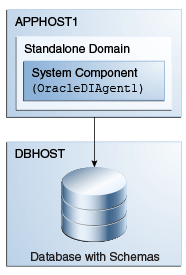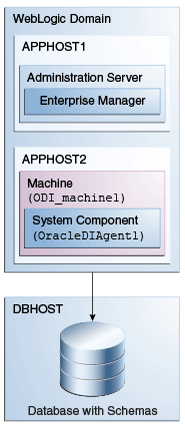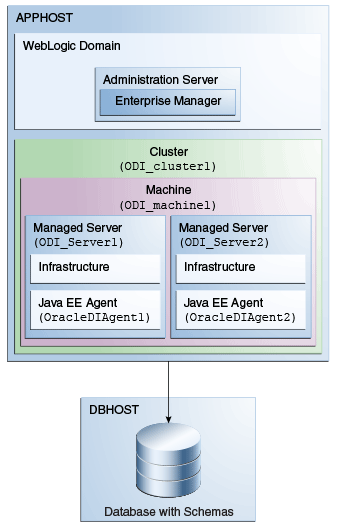1 About the Oracle Data Integrator Installation
This guide explains how to install Oracle Data Integrator (ODI) on your local system using your on-premises hardware. An alternative is to subscribe to the Oracle Cloud Java as a Service (JCS) and then install and configure ODI on JCS. For details on how to install and configure ODI on JCS, see Provisioning ODI.
- Using the Standard Installation Topology as a Starting Point
The standard installation topology is a flexible topology that you can use as a starting point in production environments. - About the Oracle Data Integrator Topology
The Oracle Data Integrator topology is the physical and logical representation of the Oracle Data Integrator architecture and components. - About Oracle Data Integrator Run-Time Agents
At design time, developers generate scenarios from the business rules that they have designed. The code of these scenarios is then retrieved from the repository by a run-time agent. This agent then connects to the data servers and orchestrates the code execution on these servers. - About Oracle Data Integrator Studio
Oracle Data Integrator Studio is a developer's interface for configuring and managing ODI. - Using This Document to Extend an Existing Domain
The procedures in this guide describe how to create a new domain. The assumption is that no other Oracle Fusion Middleware products are installed on your system.
1.1 Using the Standard Installation Topology as a Starting Point
The standard installation topology is a flexible topology that you can use as a starting point in production environments.
The information in this guide helps you to create a standard installation topology for Oracle Data Integrator. If appropriate and required, you can later extend the standard installation topology to create a secure and highly available production environment (see Next Steps After Configuring the Domain).
The standard installation topology represents a sample topology for this product. It is not the only topology that this product supports. For more information, see About the Standard Installation Topology in Oracle Fusion Middleware Planning an Installation of Oracle Fusion Middleware.
- About the Oracle Data Integrator Standalone Agent Standard Installation Topology
This topology represents a standalone agent configured in a standalone domain, managed by the WebLogic Management Framework. The domain is configured on a single host and requires a supported database where the required Fusion Middleware schemas are installed. - About the Oracle Data Integrator Standalone Collocated Agent Standard Installation Topology
This installation topology represents a standalone agent configured in a WebLogic domain, managed by an Administration Server and Node Manager. The domain is configured on a single host and requires a supported database where the required Fusion Middleware schemas are installed. - About the Oracle Data Integrator Java EE Agent Standard Installation Topology
This topology represents a standard WebLogic Server domain that contains an Administration Server and a Managed Server on which the Infrastructure and Java EE agent are deployed.
1.1.1 About the Oracle Data Integrator Standalone Agent Standard Installation Topology
This topology represents a standalone agent configured in a standalone domain, managed by the WebLogic Management Framework. The domain is configured on a single host and requires a supported database where the required Fusion Middleware schemas are installed.
Figure 1-1 shows the standard installation topology for the Oracle Data Integrator standalone agent.
Figure 1-1 Standard Installation Topology for the Standalone Agent

For configuration instructions, see Configuring the Domain for a Standalone Agent.
Table 1-1 describes all elements in this standard installation topology illustration.
Table 1-1 Description of the Elements in the Standalone Agent Standard Installation Topology
| Element | Description and Links to Additional Documentation |
|---|---|
|
APPHOST |
Standard term used in Oracle documentation referring to the computer that is hosting the application tier. |
|
DBHOST |
Standard term used in Oracle documentation referring to the computer that is hosting the database. |
|
Standalone Domain |
A container for system components, such as Oracle HTTP Server or Oracle Data Integrator standalone agents. For more information, see What Is a Standalone Domain? in Oracle Fusion Middleware Understanding Oracle Fusion Middleware. |
|
System Component |
A manageable process that is not deployed in a Java application container. A system component corresponds to a standalone agent. For more information, see What Is a System Component? in Oracle Fusion Middleware Understanding Oracle Fusion Middleware. |
1.1.2 About the Oracle Data Integrator Standalone Collocated Agent Standard Installation Topology
This installation topology represents a standalone agent configured in a WebLogic domain, managed by an Administration Server and Node Manager. The domain is configured on a single host and requires a supported database where the required Fusion Middleware schemas are installed.
Figure 1-2 shows the standard installation topology for the standalone collocated agent.
Figure 1-2 Standard Installation Topology for the Standalone Collocated Agent

For configuration instructions, see Configuring the Domain for a Standalone Collocated Agent.
Table 1-2 describes all elements in this standard installation topology.
Table 1-2 Description of the Elements in the Standalone Collocated Agent Standard Installation Topology
| Element | Description and Links to Additional Documentation |
|---|---|
|
APPHOST |
Standard term used in Oracle documentation referring to the computer that is hosting the application tier. |
|
DBHOST |
Standard term used in Oracle documentation referring to the computer that is hosting the database. |
|
Administration Server |
The central control entity of a domain which maintains the domain's configuration objects and distributes configuration changes to Managed Servers. For more information, see What Is the Administration Server? in Oracle Fusion Middleware Understanding Oracle Fusion Middleware. |
|
Enterprise Manager |
Oracle Enterprise Manager Fusion Middleware Control. For more information, see Oracle Enterprise Manager Fusion Middleware Control in Oracle Fusion Middleware Understanding Oracle Fusion Middleware. |
|
Machine |
Logical representation of the computer that hosts one or more WebLogic Server instances (servers). Machines are also the logical glue between WebLogic Managed Servers and the Node Manager; in order to start or stop a Managed Server with Node Manager, the Managed Server must be associated with a machine. |
|
System Component |
A standalone process that is managed by the WebLogic Management Framework. A system component corresponds to a standalone agent. For more information, see What Is a System Component? in Oracle Fusion Middleware Understanding Oracle Fusion Middleware. |
1.1.3 About the Oracle Data Integrator Java EE Agent Standard Installation Topology
This topology represents a standard WebLogic Server domain that contains an Administration Server and a Managed Server on which the Infrastructure and Java EE agent are deployed.
The Managed Server is targeted to a machine inside a cluster. The domain is configured on a single host and requires a supported database where the required Fusion Middleware schemas are installed. The Java EE agent is installed into an existing Oracle home containing Oracle Fusion Middleware Infrastructure. ODI Console, ODI Studio, and the plugin for Fusion Middleware Control are also installed in the topology.
Note:
The infrastructure can use more than one machine for scalability and high-availability considerations. See Preparing Your Environment for High Availability for more information.
Figure 1-3 shows the standard installation topology for an Oracle Data Integrator Java EE agent.
Figure 1-3 Standard Installation Topology for an ODI Java EE Agent

For configuration instructions, see Configuring the Domain for a Java EE Agent.
Table 1-3 describes all elements in this standard installation topology illustration.
Table 1-3 Description of the Elements in the Java EE Standard Installation Topology
| Element | Description and Links to Additional Documentation |
|---|---|
|
APPHOST |
Standard term used in Oracle documentation referring to the computer that is hosting the application tier. |
|
DBHOST |
Standard term used in Oracle documentation referring to the computer that is hosting the database. |
|
WebLogic Domain |
A logically related group of Java components (in this case, the administration Server, Managed Servers, and other related software components). For more information, see What Is an Oracle WebLogic Server Domain? in Oracle Fusion Middleware Understanding Oracle Fusion Middleware. |
|
Administration Server |
The central control entity of a domain which maintains the domain's configuration objects and distributes configuration changes to Managed Servers. For more information, see What Is the Administration Server? in Oracle Fusion Middleware Understanding Oracle Fusion Middleware. |
|
Enterprise Manager |
Oracle Enterprise Manager Fusion Middleware Control. For more information, see Oracle Enterprise Manager Fusion Middleware Control in Oracle Fusion Middleware Understanding Oracle Fusion Middleware. |
|
Cluster |
A collection of multiple WebLogic Server instances running simultaneously and working together. For more information, see Overview of Managed Servers and Managed Server Clusters in Oracle Fusion Middleware Understanding Oracle Fusion Middleware. |
|
Machine |
Logical representation of the computer that hosts one or more WebLogic Server instances (servers). Machines are also the logical glue between WebLogic Managed Servers and the Node Manager; in order to start or stop a Managed Server with Node Manager, the Managed Server must be associated with a machine. |
|
Managed Server |
Host for your applications, application components, Web services, and their associated resources. For more information, see Overview of Managed Servers and Managed Server Clusters in Oracle Fusion Middleware Understanding Oracle Fusion Middleware. |
|
Infrastructure |
Collection of services that include the following:
|
|
Java EE Agent |
The Java EE run-time agent. |
1.2 About the Oracle Data Integrator Topology
The Oracle Data Integrator topology is the physical and logical representation of the Oracle Data Integrator architecture and components.
Before you can begin developing using Oracle Data Integrator, you must first set up an Oracle Data Integrator topology, which is the physical and logical representation of the Oracle Data Integrator architecture and components. The Oracle Data Integrator topology defines where to find the sources and targets of the data that you are integrating.
Note that this topology is not the same as the standard installation topology, which is the layout of files installed and configured on your computer by the Oracle Universal Installer and the configuration wizard.
For more information, see Setting up a Topology in Oracle Fusion Middleware Developing Integration Projects with Oracle Data Integrator.
1.3 About Oracle Data Integrator Run-Time Agents
At design time, developers generate scenarios from the business rules that they have designed. The code of these scenarios is then retrieved from the repository by a run-time agent. This agent then connects to the data servers and orchestrates the code execution on these servers.
The types of run-time agents that can be configured in the ODI installation topology are:
-
Standalone agent
-
Standalone collocated agent
-
Java EE agent
For more information, see Run-Time Agent in Oracle Fusion Middleware Understanding Oracle Data Integrator.
1.4 About Oracle Data Integrator Studio
Oracle Data Integrator Studio is a developer's interface for configuring and managing ODI.
To learn how to use ODI Studio to configure and manage your ODI topology, see Configuring Oracle Data Integrator Studio.
1.5 Using This Document to Extend an Existing Domain
The procedures in this guide describe how to create a new domain. The assumption is that no other Oracle Fusion Middleware products are installed on your system.
If you have installed and configured other Oracle Fusion Middleware products on your system (for example, Fusion Middleware Infrastructure, with a domain that is up and running) and wish to extend the same domain to include Oracle Data Integrator, read Installing Multiple Products in the Same Domain for detailed information.